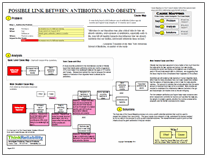On August 10, 2012, a living donor’s kidney was thrown out, instead of being transplanted as planned. The incident was chalked up to “human error”, which is almost certainly part of the problem . . . but definitely not all of it.
This extremely rare, but serious, event is being analyzed by several oversight agencies, as well as a contractor hired by the medical center in Ohio where the event took place, to ensure that needed improvements are identified and put into place so this type of incident doesn’t happen again. We can examine the currently known information in a visual root cause analysis, or Cause Map. To do so, we begin with the impacted goals.
 There are many goals that were impacted as a result of this error. Firstly, the patient safety goal was impacted because the patient did not receive the transplanted kidney. This can also be considered an impact to the patient services goal. Three personnel from the hospital were placed on administrative leave as a result of the incident. This results in an impact to employees. The compliance goal is impacted because this event has resulted in a review by several oversight agencies. The living kidney donor program is currently shut down for review, which can be considered an impact to the organization goal. The kidney was disposed of improperly, which is an impact to the environmental goal. (Medical waste has strict requirements for disposal.) The loss of the donated kidney can be considered an impact to the property goal. Personnel time was taken both to attempt to resuscitate the kidney and to participate in an independent review of the donor program. These can both be considered impacts to the labor/time goal.
There are many goals that were impacted as a result of this error. Firstly, the patient safety goal was impacted because the patient did not receive the transplanted kidney. This can also be considered an impact to the patient services goal. Three personnel from the hospital were placed on administrative leave as a result of the incident. This results in an impact to employees. The compliance goal is impacted because this event has resulted in a review by several oversight agencies. The living kidney donor program is currently shut down for review, which can be considered an impact to the organization goal. The kidney was disposed of improperly, which is an impact to the environmental goal. (Medical waste has strict requirements for disposal.) The loss of the donated kidney can be considered an impact to the property goal. Personnel time was taken both to attempt to resuscitate the kidney and to participate in an independent review of the donor program. These can both be considered impacts to the labor/time goal.
Once we have determined the impacts to the goals, we can ask “Why” questions to develop the cause-and-effect relationships that led to these impacts. In this case, the patient did not receive a kidney transplant because the kidney was thrown out and because of concern about the kidney’s viability. Part of this concern was the delay in actually finding the kidney, likely due to the fact that it was disposed of improperly. The reason given by the medical center for the disposal of the kidney is “human error”. However, there is ordinarily a support system involved in organ transplants that would minimize these types of errors. Certainly the fact that the program has been stopped and three employees – at least one of whom was not directly involved in the transplant operation – were placed on administrative leave suggest that the organization is looking at more than just a screw-up by one person acting alone.
Specifically, the investigation should look at communication – was the nurse who disposed of the organ told it was destined for transplant? Was there a surgical time-out immediately prior to the removal with the entire operating team that discussed the plan for the kidney? Also the training and preparation of the surgical team should be investigated. Had the team been properly trained and prepped for this type of surgery? The fact that it was done frequently at this facility doesn’t mean that adequate training was in place. What about the procedure for treatment and supervision of donated organs? Donated organs have to be treated in a very particular way to ensure their viability for the transplant patient. Who, if anyone, was responsible for ensuring that the organ was prepared in a proper way for transplant? Were they involved in the surgical time-out? Lastly, because an error was made with the disposal procedure, the procedure, training and communication regarding disposal of medical waste needs to be analyzed to ensure it is adequate. The hope is that by doing a thorough review – and improvement – of policies, procedures, training and communication at the facility, it will not only reduce the risk of this type of error, but provide improvement in many other aspects of the care provided as well.
To view the Outline and Cause Map, please click “Download PDF” above.




